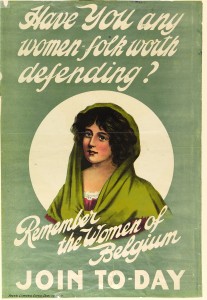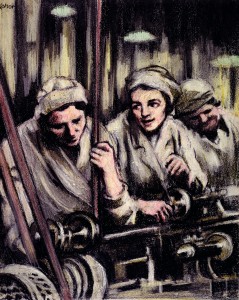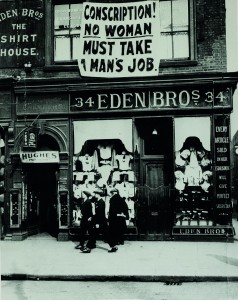Women and war in Ireland, 1914–18
Published in Decade of Centenaries, Features, Issue 4 (July/August 2014), Volume 22
Remember the women of Belgium’! (National Library of Ireland)
Irish women were well placed to adapt quickly and efficiently to the challenges initiated by Britain’s declaration of war against Germany in August 1914. The country’s existing network of philanthropic and political organisations provided a firm foundation for a wide variety of voluntary war work, and they were quickly bolstered by a raft of new societies, established explicitly to coordinate Irish women’s contribution to the allied war effort.
The majority of Irish women did not appear to be opposed to Irish involvement in the war and responded energetically and willingly to calls for their assistance. Responsibility for organising voluntary nursing services was devolved to a Joint War Committee, prompting some rivalry between it and the National Council of Trained Nurses. There is little evidence, however, that certified nurses were usurped by the volunteers, who usually qualified for service after training for about three months. Professional nurses usually had several years of training and experience and were thus in high demand during the war. They were such a valuable commodity that they were rarely replaced by VADs, who were expected to do most of the menial and unskilled work. Voluntary detachments were organised on a county basis and segregated by sex. Their work varied according to the location of individual detachments and on shifting needs, but included hospital and ambulance duties in an auxiliary capacity, as well as non-medical war work such as sewing, making up bandages, collecting supplies and working with local fund-raising committees. The vast majority of Irish volunteers were based at home, but some Irish women served as nurses in European war zones and even as far as Gallipoli. Theirs was unglamorous but necessary work which complemented the wider voluntary initiatives, which were launched by both existing women’s societies and new groups, formed explicitly to meet wartime requirements.
‘Partition’

Girls at munitions by William Conor. Some women moved into jobs formerly done by Irish men, but not on the same scale as other parts of the UK. (William Conor estate/Ulster Museum Collection)
‘Partition’ became a well-established fact of war relief, evident in the less-than-friendly rivalry that developed between the largely unionist Ulster Gift Fund and the Irish Women’s Association. Both had been established as non-political bodies that aimed to provide comforts for Irish servicemen, but in reality the care they provided was informed by geographical and political considerations. This demarcation extended to the organisation of VADs. The British Red Cross and the Irish section of the St John’s Ambulance Association together coordinated the civilian voluntary effort for Munster, Connacht and Leinster, while the Ulster committee elected to operate separately. Such segregation was replicated in other war-related establishments, including the War Hospital Supply organisation, a depot for receiving and distributing sphagnum moss, a Prisoners-of-War relief committee and a Sailors’ Help society, each of which had separate replicas in Ulster.
Such political considerations did not, however, affect most Irish women’s voluntary work, which was, by any standards, considerable and varied. The Cork branch of the British Red Cross Society, for example, made and despatched 270,000 bandages, dressings and other types of hospital equipment, as well as 53,500 articles of clothing for soldiers. Women’s branches of city and country recruiting committees organised comforts for soldiers as well as acting as bureaux of information for their families, while women and girls knitted, sewed and collected mosses and eggs, many in addition to their paid work.
Economic impact

‘Conscription! No woman must take a man’s job’—banner hanging c. 1916 from the offices of the pacifist Irish Women’s Franchise League, which absolutely condemned both the war and the Irish women who participated in war work of any kind. (Getty Images)
The war’s economic impact on working Irish women was uneven. Some moved into jobs formerly done by Irish men and many looked for jobs in Britain. But employment opportunities varied significantly over Ireland and they were not as greatly altered as they were in other parts of the British Isles. The industries that traditionally employed the largest numbers of women, especially domestic service and agriculture, continued to do so. Some women, particularly in Ulster, benefited from increased demand in linen mills and shirt-making factories, and many agricultural workers profited from the higher demand for their labour. Munitions factories were few and far between, and while c. 1,400 women found work in the state-owned factories established at Dublin, Waterford, Cork and Galway, this industry did not became a major employer of Irish women. Women’s involvement in trade unions expanded during the war, offering new forms of protection to mainly urban working women, but the underemployed or unemployed, on the other hand, were often disadvantaged by rising prices and the scarcity of some foods. Women’s employment prospects were also affected by the almost complete halt to emigration to America from the first half of 1915, and high rates of unemployment before the war meant that gaps left by enlisting men could easily be filled by other men rather than by unemployed women. Ireland’s exemption from conscription exacerbated this.
The question of the war’s economic impact on working women became more urgent as women’s groups attempted to provide assistance for those women who had lost their jobs as a result of the war. They soon learned that difficult economic conditions could provide opportunities as well as obstacles. The Suffrage Emergency Council (SEC), for example, a body established to co-ordinate feminist responses to the war, set up classes in embroidery, woodwork and needlework and helped to establish a toy-making industry for female workers. The Dublin branch of the Church League for Women’s Suffrage also established a workroom where unemployed women made clothing and other items, as did the Dublin Toy-making Relief Committee. These occupations may appear rather frivolous in the context of total war, but the women who had been employed in manufacturing luxury goods were among the hardest-hit workers. The SEC claimed that some of the women who came to their rooms looking for work ‘actually fainted for want of food’. These women produced items that had traditionally been imported from Germany (es-pecially toys and fine embroidery), and others were trained to replace German workers such as waiters. Their experiences reflected wider retrenchment in non-essential industries, which were hit hard by the collapse in demand for luxury goods.
Political impact
The political impact of the war proved controversial, not least because many women’s political groups were already divided over the national question, as well as over militancy and pacifism, when war broke out. The pacifist Irish Women’s Franchise League absolutely condemned both the war and the Irish women who participated in war work of any kind. This was not a unique position among feminist organisations across Europe but it was very much a minority view, in Ireland and across the world. The vast majority of women’s suffrage and social reform groups did take up voluntary war work, usually prompted by patriotism and concern for the victims of the conflict. While acknowledging that views on the efficacy of the war varied among Irish women, Dora Mellone, secretary of the Irishwomen’s Suffrage Federation, for example, argued that ‘the war is here. If the nation is to be saved women must help in the saving.’ In common with many other suffragists, Mellone undertook war work in tandem with suffrage activity. Some members of her own organisation, which functioned as an umbrella body for most Irish suffrage societies, had considered abandoning suffrage work for the duration, but they were outvoted by their colleagues, who agreed to cooperate with the Suffrage Emergency Council.
The war’s impact on the Irish suffrage movement was mixed. Some societies ceased or radically reduced their political work, while others were invigorated by it. The Belfast branch of the Church League for Women’s Suffrage, for example, claimed to have doubled its membership during the war. The foundation of the Irish Catholic Women’s Suffrage Society in 1915 similarly suggested that the movement’s appeal survived throughout the war years. Most feminist societies, even those whose memberships included pacifists, participated in the war effort by fund-raising, endowing hospitals, ambulances and beds for wounded combatants, as well as providing support for their families. A good deal of optimism about post-war prospects for women was also expressed. Edith Somerville of the Munster Women’s Franchise League looked to the position of women in post-war Ireland as early as 1915, when she and Violet Martin began to compile a record of the ‘magnificent’ work done by suffragists. This, she argued, would in the future ‘form an argument in our favour hardly to be gainsaid’. Edith Londonderry agreed and even accepted a bet in 1915 that suffragists would have won their case by the end of the war. None of these women could have known that the war would drag on until 1918, but their optimism about its impact on women’s citizenship and employment rights was widely shared and based on clear evidence that the war had provided a context in which new opportunities and responsibilities had become available to Irish women.
Moral police force?
Feminist activists took advantage of wartime conditions and moral panics to pursue some of their favoured causes, as well as tackling new social problems, all of which were believed to have been exacerbated by war. One of the most important was the Irish Women Patrols (IWP), a kind of voluntary civic police force composed entirely of women, who patrolled the streets of Dublin and aimed to ‘improve the moral and social conditions of the streets and to safeguard young people of both sexes’. Their work complemented the foundation of many cafés and clubs, launched to provide ‘safe’ places for young people to meet, away from the temptations of alcohol, sex and the attractions of Dublin’s streets after dark. The IWP proved to be remarkably successful and helped to pave the way for professional women police, but it inevitably attracted dissent, not least because of the fear that it would function as a moral police force. Though controversial, the IWP was only one of many examples of social reform activism and experimentation that flourished from 1914. While the war caused undoubted hardship to many Irish families, it also provided social reformers with a unique context in which a number of existing social questions could be tackled with renewed energy and more openness than was usual. Frank discussion of issues such as prostitution, sexual disease, sexual violence against women and children, alcohol abuse and women’s unequal status under the law featured in the country’s press and in lively feminist and social reform campaigns over the war years.
Although it concerned the behaviour and conditions of poor women in the main, much of this debate was spearheaded by middle-class women and men, and it would be naïve to imagine that all Irish women’s war-related experiences were not similarly shaped by geographical, political, social and religious differences. Economic hardship was unevenly felt, but the determination to ‘do their bit’ united most women across Ireland, temporarily at least.
Senia Pasˇeta is a tutor in modern history at St Hugh’s College, University of Oxford.
Read More: Unionist women
Further reading
C. Clear, ‘Fewer ladies, more women’, in J. Horne (ed.), Our war: Ireland and the Great War (Dublin, 2008).
A. Matthews, Renegades: Irish republican women, 1900–1922 (Cork, 2010).
S. Pasˇeta, Irish nationalist women, 1900–1918 (Cambridge, 2013).
E. Reilly, ‘Women and voluntary war work’, in A. Gregory and S. Pasˇeta (eds), Ireland and the Great War: ‘a war to unite us all’? (Manchester, 2002).
















